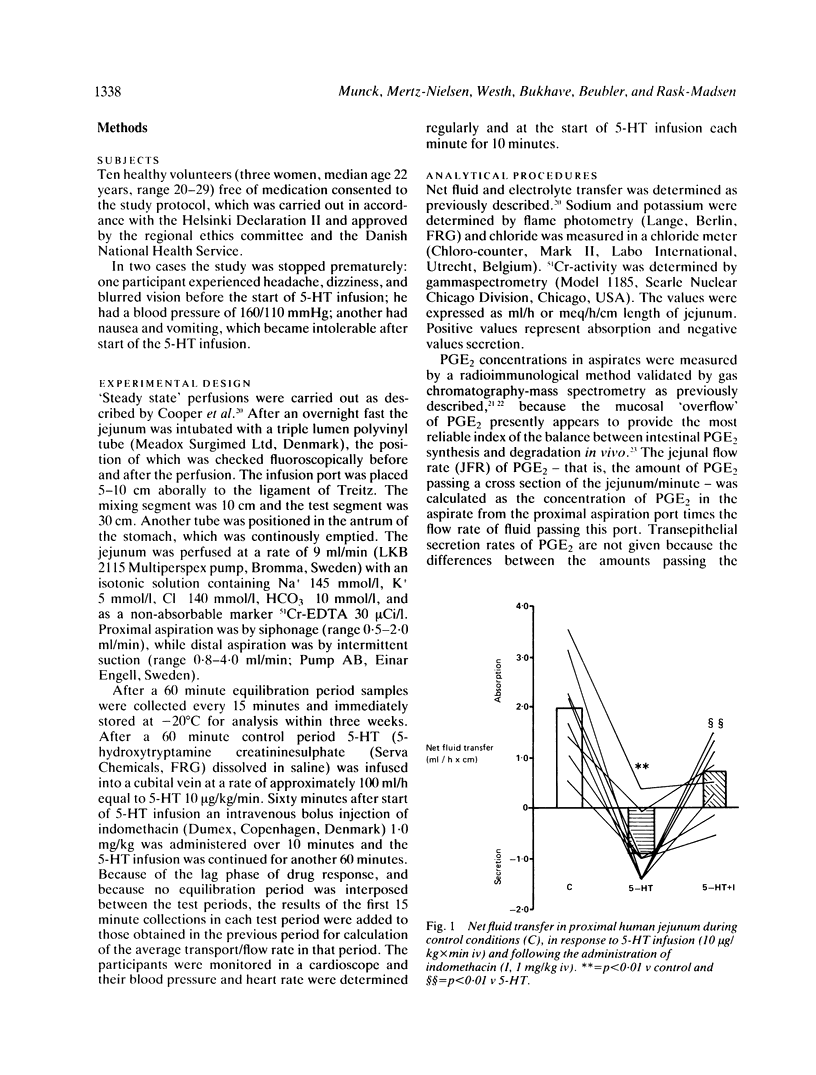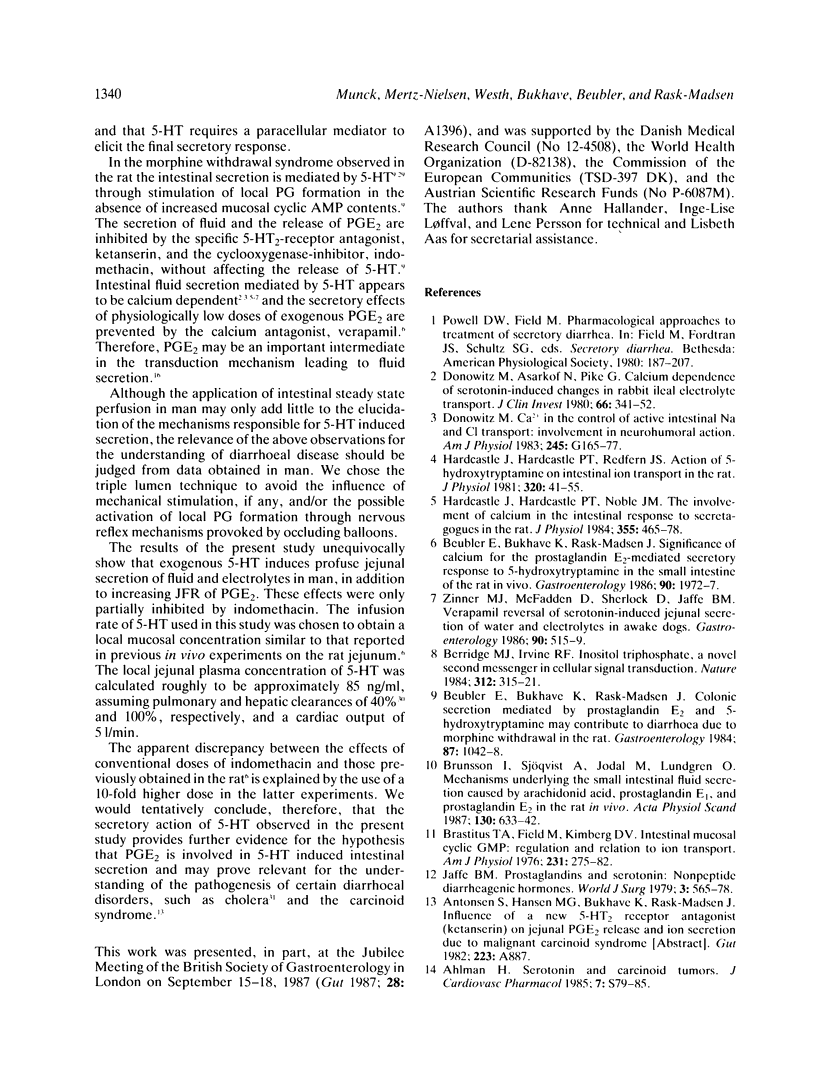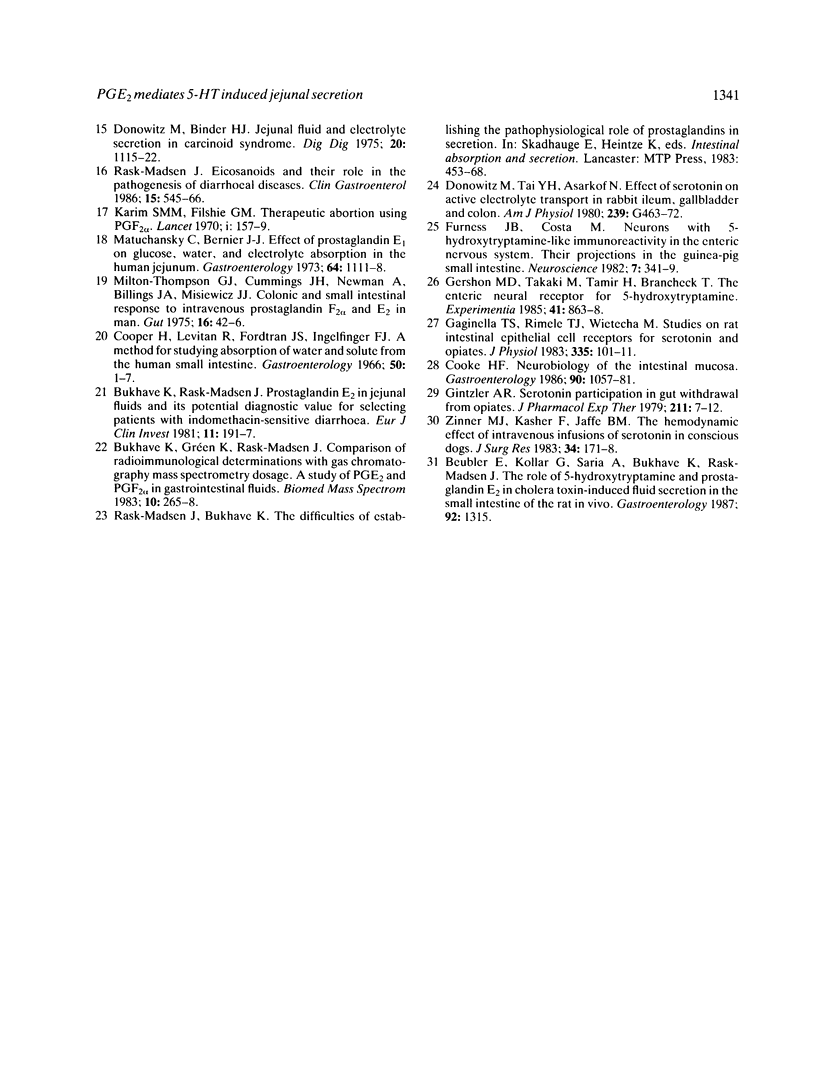Abstract
Studies in the rat jejunum in vivo have shown that 5-hydroxytryptamine (5-HT) causes secretion of fluid and luminal release of prostaglandin (PG) E2. These effects can be blocked by indomethacin and ketanserin, which suggests that PGE2 may be an important intermediate in the transduction mechanism leading to 5-HT induced fluid secretion. To test this hypothesis in man 'steady state' perfusions (9 ml/min) were done in eight healthy volunteers using the triple lumen technique. The proximal jejunum was perfused with Ringer's solution which contained 51Cr-EDTA as a non-absorbable marker. Before and after the administration of indomethacin (1.0 mg/kg iv) the effects of exogenous 5-HT (10 micrograms/kg/min iv) on jejunal net transport of fluid and electrolytes and jejunal flow rate (JFR) of PGE2 were measured in 15-min periods for 2 x 60 minutes after a 60 minute control period. 5-HT reversed fluid and electrolyte absorption into profuse secretion (p less than 0.01, Duncan's multiple range test) and significantly increased JFR of PGE2 (p less than 0.01). Indomethacin partly restored fluid and electrolyte absorption (p less than 0.01) and inhibited JFR of PGE2 (p less than 0.05). These results provide further evidence in favour of the theory that PGs are involved in 5-HT induced intestinal fluid secretion.
Full text
PDF




Selected References
These references are in PubMed. This may not be the complete list of references from this article.
- Berridge M. J., Irvine R. F. Inositol trisphosphate, a novel second messenger in cellular signal transduction. Nature. 1984 Nov 22;312(5992):315–321. doi: 10.1038/312315a0. [DOI] [PubMed] [Google Scholar]
- Beubler E., Bukhave K., Rask-Madsen J. Significance of calcium for the prostaglandin E2-mediated secretory response to 5-hydroxytryptamine in the small intestine of the rat in vivo. Gastroenterology. 1986 Jun;90(6):1972–1977. doi: 10.1016/0016-5085(86)90269-6. [DOI] [PubMed] [Google Scholar]
- Brasitus T. A., Field M., Kimberg D. V. Intestinal mucosal cyclic GMP: regulation and relation to ion transport. Am J Physiol. 1976 Jul;231(1):275–282. doi: 10.1152/ajplegacy.1976.231.1.275. [DOI] [PubMed] [Google Scholar]
- Brunsson I., Sjöqvist A., Jodal M., Lundgren O. Mechanisms underlying the small intestinal fluid secretion caused by arachidonic acid, prostaglandin E1 and prostaglandin E2 in the rat in vivo. Acta Physiol Scand. 1987 Aug;130(4):633–642. doi: 10.1111/j.1748-1716.1987.tb08186.x. [DOI] [PubMed] [Google Scholar]
- Bukhave K., Gréen K., Rask-Madsen J. Comparison of radioimmunological determinations with gas chromatography mass spectrometry dosage. A study of PGE2 and PGF2alpha in gastrointestinal fluids. Biomed Mass Spectrom. 1983 Apr;10(4):265–268. doi: 10.1002/bms.1200100406. [DOI] [PubMed] [Google Scholar]
- Bukhave K., Rask-Madsen J. Prostaglandin E2 in jejunal fluids and its potential diagnostic value for selecting patients with indomethacin-sensitive diarrhoea. Eur J Clin Invest. 1981 Jun;11(3):191–197. doi: 10.1111/j.1365-2362.1981.tb01840.x. [DOI] [PubMed] [Google Scholar]
- Cooke H. J. Neurobiology of the intestinal mucosa. Gastroenterology. 1986 Apr;90(4):1057–1081. doi: 10.1016/0016-5085(86)90889-9. [DOI] [PubMed] [Google Scholar]
- Cooper H., Levitan R., Fordtran J. S., Ingelfinger F. J. A method for studying absorption of water and solute from the human small intestine. Gastroenterology. 1966 Jan;50(1):1–7. [PubMed] [Google Scholar]
- Donowitz M., Asarkof N., Pike G. Calcium dependence of serotonin-induced changes in rabbit ileal electrolyte transport. J Clin Invest. 1980 Aug;66(2):341–352. doi: 10.1172/JCI109862. [DOI] [PMC free article] [PubMed] [Google Scholar]
- Donowitz M., Binder H. J. Jejunal fluid and electrolyte secretion in carcinoid syndrome. Am J Dig Dis. 1975 Dec;20(12):1115–1122. doi: 10.1007/BF01070754. [DOI] [PubMed] [Google Scholar]
- Donowitz M. Ca2+ in the control of active intestinal Na and Cl transport: involvement in neurohumoral action. Am J Physiol. 1983 Aug;245(2):G165–G177. doi: 10.1152/ajpgi.1983.245.2.G165. [DOI] [PubMed] [Google Scholar]
- Donowitz M., Tai Y. H., Asarkof N. Effect of serotonin on active electrolyte transport in rabbit ileum, gallbladder, and colon. Am J Physiol. 1980 Dec;239(6):G463–G472. doi: 10.1152/ajpgi.1980.239.6.G463. [DOI] [PubMed] [Google Scholar]
- Furness J. B., Costa M. Neurons with 5-hydroxytryptamine-like immunoreactivity in the enteric nervous system: their projections in the guinea-pig small intestine. Neuroscience. 1982 Feb;7(2):341–349. doi: 10.1016/0306-4522(82)90271-8. [DOI] [PubMed] [Google Scholar]
- Gaginella T. S., Rimele T. J., Wietecha M. Studies on rat intestinal epithelial cell receptors for serotonin and opiates. J Physiol. 1983 Feb;335:101–111. doi: 10.1113/jphysiol.1983.sp014522. [DOI] [PMC free article] [PubMed] [Google Scholar]
- Gershon M. D., Takaki M., Tamir H., Branchek T. The enteric neural receptor for 5-hydroxytryptamine. Experientia. 1985 Jul 15;41(7):863–868. doi: 10.1007/BF01970002. [DOI] [PubMed] [Google Scholar]
- Gintzler A. R. Serotonin participation in gut withdrawal from opiates. J Pharmacol Exp Ther. 1979 Oct;211(1):7–12. [PubMed] [Google Scholar]
- Hardcastle J., Hardcastle P. T., Noble J. M. The involvement of calcium in the intestinal response to secretagogues in the rat. J Physiol. 1984 Oct;355:465–478. doi: 10.1113/jphysiol.1984.sp015432. [DOI] [PMC free article] [PubMed] [Google Scholar]
- Hardcastle J., Hardcastle P. T., Redfern J. S. Action of 5-hydroxytryptamine on intestinal ion transport in the rat. J Physiol. 1981 Nov;320:41–55. doi: 10.1113/jphysiol.1981.sp013933. [DOI] [PMC free article] [PubMed] [Google Scholar]
- Jaffe B. M. Prostaglandins and serotonin: nonpeptide diarrheogenic hormones. World J Surg. 1979 Sep 20;3(5):565–578. doi: 10.1007/BF01654761. [DOI] [PubMed] [Google Scholar]
- Karim S. M., Filshie G. M. Therapeutic abortion using prostaglandin F2alpha. Lancet. 1970 Jan 24;1(7639):157–159. doi: 10.1016/s0140-6736(70)90402-2. [DOI] [PubMed] [Google Scholar]
- Kruis W., Thieme C., Weinzierl M., Schüssler P., Holl J., Paulus W. A diagnostic score for the irritable bowel syndrome. Its value in the exclusion of organic disease. Gastroenterology. 1984 Jul;87(1):1–7. [PubMed] [Google Scholar]
- Matuchansky C., Bernier J. J. Effect of prostaglandin E 1 on glucose, water, and electrolyte absorption in the human jejunum. Gastroenterology. 1973 Jun;64(6):1111–1118. [PubMed] [Google Scholar]
- Milton-Thompson G. J., Cummings J. H., Newman A., Billings J. A., Misiewicz J. J. Colonic and small intestinal response to intravenous prostaglandin F2 alpha and E2 in man. Gut. 1975 Jan;16(1):42–46. doi: 10.1136/gut.16.1.42. [DOI] [PMC free article] [PubMed] [Google Scholar]
- Rask-Madsen J. Eicosanoids and their role in the pathogenesis of diarrhoeal diseases. Clin Gastroenterol. 1986 Jul;15(3):545–566. [PubMed] [Google Scholar]
- Zinner M. J., Kasher F., Jaffe B. M. The hemodynamic effects of intravenous infusions of serotonin in conscious dogs. J Surg Res. 1983 Feb;34(2):171–178. doi: 10.1016/0022-4804(83)90057-4. [DOI] [PubMed] [Google Scholar]


